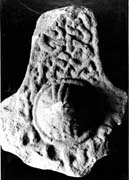Select a site alphabetically from the choices shown in the box below. Alternatively, browse sculptural examples using the Forward/Back buttons.
Chapters for this volume, along with copies of original in-text images, are available here.
Object type: Part of cross-head [1]
Measurements: (after Collingwood 1915a) H. 28 cm (11 in); W. 23 cm (9 in); D. 10 cm (4 in)
Stone type: Not recorded
Plate numbers in printed volume: Ills. 221-4
Corpus volume reference: Vol 8 p. 145
(There may be more views or larger images available for this item. Click on the thumbnail image to view.)
The centre and part of one arm of a cross-head with curved armpits. The faces appear to have been edged with roll mouldings.
A (broad): The centre is enclosed by a ring, apparently rolled. It is a large boss filled by a triple outline incised cross of type E6. Around the ring Collingwood (1915a, 168, fig. l) drew a border of a simple twist, completely detached from the pattern in the one surviving arm. The twist does appear to be there, but it is not entirely separate from the pattern in the arm (see face C), which itself is not as Collingwood drew it. It appears to be based on pattern F with diagonals through the element: these form an irregular terminal including a pattern C-like loop, in which some of the strands feed into the encircling twist, which at this point is larger and more angular than in the portion edging the surviving armpit.
B and D (narrow): Both largely incomplete, the armpit (face B) possibly plain.
C (broad): A boss at the centre is surrounded by a triple roll moulding. Around this a simple twist clearly connects with the interlace in the arms, as shown in the one surviving arm. The pattern there is again slightly different from Collingwood's version (1915a, 168, fig. m). He shows one register of half pattern A with outside strands, whereas it is actually one register of half pattern F with outside strands.
Collingwood's drawing and the photographs both suggest a fine-stranded interlace. It would have been interesting to compare the angular twist with that on the sides of Dewsbury 10 above, although the thickness and different edging show that this was not part of the same monument. Nevertheless at a thickness of four inches, this was also apparently a small slender monument. The use of the twist to link the patterns in the arms seems innovative, although face A shows this less neatly executed than does face C.



